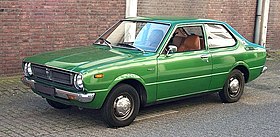Toyota Corolla (E30)
| Third generation | |
|---|---|
 |
|
| Overview | |
| Production | Aug 1974–July 1981 |
| Assembly |
Toyota City, Japan Port Melbourne, Australia, Thames, New Zealand, Samut Prakan, Thailand |
| Body and chassis | |
| Body style | 2-door coupe 2/4-door sedan 2-door hardtop coupé 3-door liftback 3/5-door station wagon 3-door van |
| Layout | FR layout |
| Related | Sprinter, Daihatsu Charmant |
| Powertrain | |
| Engine | 1.2 L 3K I4 1.3 L 4K I4 1.4 L T I4 1.6 L 2T I4 1.6 L 12T I4 |
| Transmission | 4/5-speed manual 2/3-speed automatic |
| Dimensions | |
| Wheelbase | 2,370 mm (93 in) |
| Length | 3,995 mm (157.3 in) |
| Width | 1,570 mm (62 in) |
| Height | 1,375 mm (54.1 in) |
| Curb weight | 880 kg (1,940 lb) |
| Chronology | |
| Predecessor | Corolla E20 |
| Successor | Corolla E70 |
The Corolla E30 was the third generation of cars sold by Toyota under the Corolla nameplate. It was built from August 1974 to July 1981 and marked Toyota's greatest growth in the United States in the wake of the fuel crisis. In addition to its sister model, the Sprinter, there was a redesigned-body version built by Toyota affiliate Daihatsu, called the Daihatsu Charmant. While there were certain fourth-generation models with a longer model life, this generation, when considered as a whole, was the longest-lived one, possibly due to the worldwide recession in the 1970s. A large range of cars were built using this chassis, including Corollas, Sprinters, Daihatsu, and the sporty Levin and Trueno models with the DOHC motor, with a fuel injection upgrade added to Japanese Levin models in January 1977.
The 3K engine was used in certain markets and later the 4K, while most Japanese and American models had the bigger 2T engine. A "Toyoglide" 2/3-speed automatic transmission was added as well as a four-speed and five-speed manual transmission, driving to the rear wheels. A three-door "liftback" (E50) and sports coupé (E51) was added in 1976. The E40 and E60 series were assigned to the Sprinter variants. In 1975, Toyota introduced the TTC-L (Toyota Total Clean-Lean Burn) on the 12T engine only, using a lean burn implementation.
Even though the E30 and E50 series were replaced by the E70 series in August 1979 in most markets, the original E30 series and the facelifted E50 series both continued production until July 1981.
Japanese market engines:
Japanese market chassis:
The 40- and 60-series were reserved for the Corolla's slightly more expensive Sprinter sibling.
Road & Track was critical of the 1975 Corolla (introduced to North America in late 1974), calling it "large and heavy" and "expensive" compared to the Honda Civic and Datsun B210. They also criticized the "relatively crude rear suspension", lack of interior space, and poor fuel economy when compared to the VW Rabbit. The base model cost US$2,711 in 1975, but only the $2,989 "deluxe" model had features comparable to the contemporary pack.
...
Wikipedia
